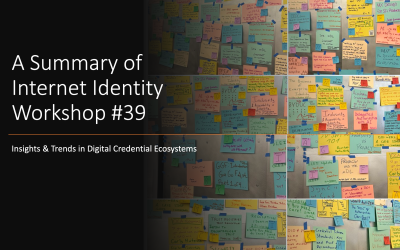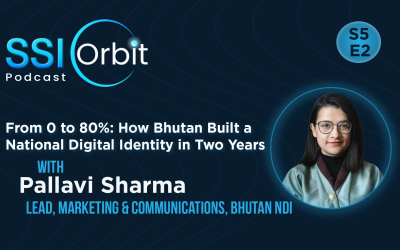Hello everyone, my name is Mathieu Glaude. I’m the founder and CEO of Northern Block, a leading global technology provider of Self-sovereign Identity (SSI) solutions. Northern Block is proudly Canadian, and our headquarters are in Toronto, Canada.
The title of my presentation is: “Lessons from the Front Line: Building Self-sovereign Solutions for Mid-tier FinTechs.”
I’ll explain the identification of mid-tier FinTechs as a target market a bit later on in the presentation. In short, it involves the collaborative platform business models that are made possible for FinTechs. The results will unlock a web of network effects, but we’ll get to that.
I’d like to start the presentation by taking a couple of steps back to explain how we got to Self-sovereign solutions. I have a couple of stories about two distinct front-line experiences that will explain how I got here. The first goes back to when I started my career at Capital One bank, on the front-line of a call-center. The second story comes from my experience of being on the front-line of decentralization while running Northern Block for four years as a consultancy. The company focused on building centralized solutions that leverage blockchain and other distributed computing mechanisms.
Looking back at my early career at the Capital One call center, it was a significant learning experience being at the intersection between the customer and the company. In any organization, no one has a better understanding of the customer than a front-line customer service agent. By being in that role, I quickly realized that people would call for the same issues repeatedly. A principal reason was a request for password resets, which I think was about 25% of call volume. People would call to obtain their account balance, call about a lost or stolen card, or call to inquire about a credit limit increase. There were a few other reasons why people would request support over and over again.
All of these calls are a result of increased friction for the customer. Having to phone the call center is never a fun time for anyone, so any need for a customer to phone a call center is a service failure by the company. That being said, many companies have call volumes today that are still in the millions of calls annually. They waste large sums of money authenticating and then attempting to service customers that they don’t know much about. Customer Service Reps typically don’t have much visibility into the customer. They don’t have much visibility into previous interactions with the customers; they also don’t know much about the customer, other than the customer’s name or maybe some just high-level account details.
One item of note that I noticed while working the phones in the call center was that most calls were from existing customers who had already been serviced with some products. They weren’t prospective customers, but they were existing customers. Reviewing the large volume of calls that would come in every day, I began to realize that it would only take a few small investments to prevent customer issues from recurring. Examples of this would include improving communications and making some small feature updates for better online experiences. The business didn’t fully realize the correlation of these specific issues to call volume, so I tried to design a solution. I started developing a taxonomy of call reasons. Once I had the list, I taught myself how to code, and built a call logging system for service agents. I slowly launched this system in one call center, then in a second. Then, slowly across others until the approach went international.
It all went pretty well, but suddenly, I had all of this data about customers. As a result, I got into data science because I had the data, and I wanted to do something to create value out of the data. So, I got my hands dirty, working to generate some business cases for the business.
As these business analysis projects matured and I stabilized the whole process, I transitioned into digital products to build online banking and call center software. The entire experience led me to see some trends. These trends weren’t only happening within the bank but everywhere. It wasn’t hard to notice that cyber-security risks were on the rise — both for organizations and for people. We were seeing mistrust not only in institutions but also in companies. Organizations and people were continuously being segmented incorrectly.
We still see that happening today. If you look at how people were segmented into different demographics to predict the USA’s last elections, you’ll see that it doesn’t work that well anymore. Nowadays, people have access to so much information. It’s more open, and it’s more global because of the internet. Every person is unique; everyone has their own characteristics, so it’s tough to segment people together. It doesn’t work effectively anymore, and finally, that approach disconnects the voice of the customer. As organizations, we chase the concept of KYC (Know Your Customer), but do we truly know the customer?
In the slide, you can see that I categorize those trends that lead to friction on the left side of my graphic. Around that time, I was beginning to gain some exposure to crypto and blockchain companies through Capital One’s venture arm. Capital One was beginning to make limited investments into blockchain companies. I began to study the process and became deeply obsessed with the potential of blockchain and decentralization. I saw everything going digital; software was already devouring the world and was starting to eat away at finance. I saw so many opportunities for blockchain to be used there.
One of the attractions of blockchain is the promise of bringing more virtuous and trustworthy governments. Decentralized control of the underlying systems or protocols can cause a leveling effect that distributes value to users more fairly. It limits exploitation, it could remove barriers to entry, and it could also increase opportunities for disruptive innovation and value creation. In my slide graphic, I’ve labelled that second group of trends as “working in silos”. Decentralization could help get us out of these siloed environments. The final trend is the drive for consumer privacy.
I’ve said it before, and I’ll say it again: For me, privacy is the killer feature of the whole decade of the 2020’s. We’re only at the beginning, and we’re going to see the importance of privacy continue to rise. That drove me into the world of decentralization, where there’s never a dull moment. So, my second front-line experience began at the forefront of decentralization.
I founded Northern Block as a technology provider of decentralized solutions. Over the past few years, we’ve amassed quite a war-chest of both technical and strategic knowledge about centralized business models. We’ve deployed over 30 different software products working with Fortune 1000 companies. We’re also working with entrepreneurs on their start-ups. We’ve tokenized just about anything that you could think about tokenizing, and we’ve developed expertise across many different blockchains and tech stacks.
There was one key concern that we had been aware of, but it became more evident and more critical as we deployed more ecosystem solutions that leveraged blockchain. We faced obstacles when it came to user management. It was super that we had these decentralized systems, but how did we manage users? How did we onboard users? How do we manage their access rights? How did we manage their compliance?
We had no good way of managing those challenges in a decentralized manner that really supported the whole Self-sovereign ethos of why we got into the space. So, we got very curious and focused on solving this problem, and we spent a year in R & D trying to understand clearly the potential of the centralized identity.
While doing this, I kept being brought back to my customer service days. If you search for “customer experience” on Google, it yields close to 700 million results. It’s clearly a hot category, meaning it’s one in which very many companies sell a high number of products and services to other companies. The top result in that search is a Wikipedia article on the topic.
I quote: “In commerce, customer experience is the product of an interaction between an organization and a customer, over the duration of their relationship.” The important components that you should make a mental note of here are both the interaction and the relationship. The quote continues: “This interaction is made up of three parts: the customer journey, the brand touchpoints, and the environments the customer experiences.”
This slide shows a helpful graphic that illustrates the customer journey. As we thought more about this, there’s one big thing this illustration doesn’t do very well. That is, conveying the real ratio of both sides of the customer journey — the ratio of “buy versus own”. Our lives are filled with things we have already bought, and we spend 100 percent of our lives with those things. This paralleled the call center experiences, where the large majority of calls were from existing customers, not new leads. The true ratio is more similar to the next graphic slide, where the “own” opportunity for existing customers is much larger than the “buy” opportunity for new potential clients.
Even the shopaholics among us only buy stuff a small percentage of the time, if we consider the “curb weight” of solutions in the world of interactions between companies and customers today. In the “buy” loop of the customer journey, we have all of the global advertising spend, which represents more than a trillion dollars annually. Plus, we have tens and tens of billions of investments in CRM (Customer Relationship Management), and we have all the rest of the spend for marketing, which has way too many segments to even bother looking up.
In the “own” loop, we have trillions of dollars of greenfield opportunities for the two words I had you take a mental note of earlier: “interactions and relationships”. Our thinking was: ” Wouldn’t it make complete sense for customers to be in charge of their side of these relationships?” Preferably, this would be accomplished through methods of interaction that customers control themselves.
That vision led us to create the “NB Orbit” product suite. Of course, NB Orbit uses Self-sovereign Identity. That is, identity and attribute data that gets funneled through a wallet or an agent that the user employs. We use open and standardized frameworks. We use W3C-verifiable credential data models. For example, we use Trust over IP’s dual governance and tech stack model, and we’re currently participating in the Pan-Canadian Trust Framework (PCTF) alpha testing within the DIACC (Digital ID and Authentication Council). That’s quite exciting, and we’re thrilled about that.
All these components allow the user to obtain verifiable and potentially trusted data from the parties they interact with, and to share that data with other parties. The credentials are fully portable and reusable. As onboarding happens, people become participants of an orbit or an ecosystem. You can see in this slide the mobile device that represents a consumer communicating in a peer-to-peer manner with an organization. They can exchange verifiable credentials, use private peer-to-peer chats, manage data they want to share or data they don’t consent to share, and manage their personas from the wallet. A consumer could also get verifiable credentials directly from the wallet, such as a government-issued ID, by simply scanning their government ID and performing a liveliness test. We’ve taken a top-down onboarding approach, where we first onboard ecosystem admins who create the orbit. The admins are then able to onboard partner organizations, who are able to subsequently onboard their employees. The process continues to cascade down, through employees and through customers.
It’s an extremely scalable architecture that enables a network effect to happen pretty quickly. In this slide, we see a workflow. Workflows can be customized and could specify the type of verifiable data to ask for in proof requests. All of these workflows can be directly consumable via APIs. This is superb for an ecosystem developer who may wish to white-label a solution, but it’s also applicable to organizations who have developers wanting to integrate this directly into their system. It’s easy to do, and as a result, every authentication and access function is driven by verifiable credentials. Again, this approach makes it very scalable. The system works very well alongside existing identity and access management systems that an organization may already have implemented. It’s complementary, and it works phenomenally well with centralized solutions. This enables us to return to the issue we had been having with the existing decentralized solutions we were building. This approach solves so many problems for us, and it’s fantastic.
Now, I’d like to conclude this presentation, addressing why this all matters to us; why we think it’s important to the FinTechs we’re working with now, and the ones we’re going to work with in the future. I’ll go back to our experiences and lessons learned from being on the front line of the centralization. We noticed a trend amongst other leveling technologies, such as communication networks, that they first start as decentralized but then become more centralized over time. The associated value capture eventually becomes concentrated into a small number of large business entities that have higher rates of value extraction. This historically cyclic behaviour is quite well documented, but we’ve thought about it quite a bit. One could argue that although the internet started as a great leveler due to its decentralized networking, most of its value is now being concentrated in a handful of companies that we all know well. Once centralization occurs, innovation and value creation both decrease and value extraction increases, to the detriment of the average user. This description is all too well known. We see this happening over and over again with platforms. For a moment, let’s take a step back and ask ourselves the question, “What is a platform?”
A platform is defined as a type of business model that derives a majority of its value from network effects. Examples of platform business models that we all know are AirBnB or Uber. The primary advantage of a platform business model is that network effects are able to capture value better than any other type of business model. The most valuable enterprises in the world today rely on network effects and platforms. In its simplest form, a platform is a network that connects the demand-side with the supply-side of products and services. It connects buyers and sellers. The platform’s primary role is to foster value transfer by connecting parties through finding, filtering, and matching. Connecting participants from both sides of the network and then facilitating transactions between them, reduces friction to achieve a goal. It becomes cheaper and more accessible to do things that you previously might not have done.
How do they reduce friction? To answer that, let’s reframe friction as transaction costs. The primary function of a platform business model is to offer a reduction in transaction costs.
Let’s break down transaction costs, of which there are three categories:
-
- “Triangulation”, which is another word for connecting, or helping to find, filter and match;
-
- “Transfer”, another word for facilitation which could include the transport delivery payment; and
-
- “Trust transaction costs”, which include the costs of ensuring competency, reliability, and honesty in the transaction.
Trust transaction costs could also include the costs of maintaining privacy and the alignment of interests between parties. For many platforms, explicit trust costs include aspects such as setting up user accounts with authentication and authorization, while other trust costs may be hidden. For higher value transactions that hold more risk (for example, FinTech or financial transactions), the trust costs are always going to be higher. So, the important takeaway here, is that reducing total transaction costs (reducing the sum of triangulation, transfer and trust) is the vital activity of any platform. Platforms make trade-offs between all these different types of costs, in order to offer the best possible platform to their target customer. For FinTechs, who have high trust costs, using something similar to NB Orbit, and using Self-sovereign Identity and verifiable credentials, they’re actually able to enjoy fewer trade-offs than they may have had previously. There’s not necessarily a requirement to increase the spending on trust if you’re inside an ecosystem and collaborating within an orbit or between orbits. Ecosystem solutions could be the answer for FinTechs. Portable and verifiable credentials shared between platforms will significantly reduce trust costs.
I’ve gone into depth describing platforms, and Self-sovereign Identity, and decentralization to some extent: this has all been in order to make it easier to introduce the concept of a meta platform. This is where we’re going with NB Orbit. We’re enabling FinTech ecosystem solution providers to leverage the power of Self-sovereign Identity and to set up their own orbit (i.e. their own platform). At the same time, it’s possible to leverage other orbits (other platforms or other ecosystems) to access credentials and issuers and customers. NB Orbit enables meta-platform formation. In other words, a platform that enables and fosters participant-controlled value-transfer across and among other platforms. Since platforms are a type of network, a meta-platform enables a network of network effects. I’ll argue that a network of network effects results in the most valuable kind of network effects, especially for participants on the associated platforms. Each platform participant can move as desired between platforms with very little friction, by managing one’s own digital credentials. There are just tons of opportunities to use the portability and verifiability properties to gain interoperable value-unlocking. There are opportunities for these platforms to cross-sell, upsell, and so on. The possibilities are simply endless. Most importantly, this allows for FinTech platforms to compete effectively against the large dominant market players, and truly disrupt for the better.
I’ve presented to you the exciting direction that we’re going in. Today we took a look back at my lessons learned from both front-line roles that I described earlier. This model is a complete game-changer on both fronts.
I’ll close quickly because I know I’m running up against time here. We’re just about to launch a beta testing program for NB Orbit. We do have limited participation space left, but if you’re an ecosystem solution builder, or want to learn more about the vision, or how you could get involved, I’d love to hear from you.
Honestly, collaboration is key to unlocking all this immense value that we’re talking about. There’s a need for strong allies and strong partners to achieve the vision, so please reach out to me. You can find me online; I’m active on Twitter and LinkedIn. Alternatively, you can search for me online, or find our website, at www.NorthernBlock.io.
I look forward to hearing from you, thank you!
Related Links:
Verifiable Credentials Guide for Fintech Businesses
SSI for Organizations – Ultimate Guide







